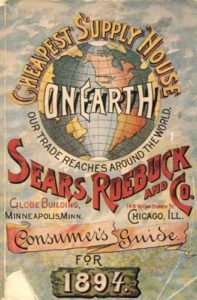Before we can even talk about making a successful catalog to digital transition, we need to go back to the history… the what, why, when and how they became a successful marketing tools.
History of Catalogs
Contrary to everything I was told growing up, catalogs are not a US concept and Sears wasn’t quite the pioneer I thought. The first catalog (on record) dates back to 1498 in Venice when Aldus Manutius created a catalog of the books he was printing. It was almost 60 years after Gutenberg invented the printing press.
In 1845 the first documented catalog produced in the US was by Tiffany & Co. It actually wasn’t until 1888 that my fellow Minnesotan, Richard Warren Sears, made his mark with the Sears Catalog. 103 years later, Sears was surpassed as the largest retailer. Pretty good run, huh? (Unless you’re currently a stockholder)


History of the World Wide Web
While many people, including Nikola Tesla, had conceptualized the idea of the internet, it wasn’t until memos from J.C.R. Licklider (1962) outlined the idea of an “Intergalactic Computer Network” that computer scientists began taking the concept seriously.
The first working “Internet” was created in the late 1960s by the Advanced Research Projects Agency Network (ARPANET) which was originally funded by the Department of Defense. In 1990, however, the World Wide Web (WWW) as we know it was created by Tim Berners-Lee.
Let’s be honest though, the concept was unfamiliar and people didn’t initially know how to use it. I think the Today Show captured it best with this 1995 montage:
For the record, the Today show now has almost 17 MILLION visits each month. AND Katie Couric clearly figured out the internet! Just check out a few of her web stats:
- 4,400,000 search results in Google
- 556,000 Instagram Followers
- 1.74 Million Twitter Followers
- 629,247 people follow her on Facebook
- 424,365 followers on LinkedIn
- 79,066 subscribers on YouTube
The World is Changing
Ok… Catalogs have been around for 521 years. The internet, while conceptualized 60 years ago, became a potential business channel 29 years ago. If history is the best predictor of the future, then catalogs are the way to go, right?
Before you say “yes”, think about this… Karl Benz received the first motorcar patent in 1886. That was two years before Sears sent out its first catalog.
I haven’t seen many of these driving to the grocery store lately. Have you?
We’ve come a long way in 130+ years. We’ve invented some unbelievably revolutionary things: electricity, airplanes, spaceships, computers, cell phones and (this is true) even ZIPPERS! We’re doing things at an unprecedented pace. We’re changing at an unprecedented pace!
If you don’t believe me, consider a much more recent event. Check out this CNBC interview from 2004. It was only 15 years ago…
Facebook now has 2.23 BILLION monthly users.
Catalogs have been a business channel for over 500 years… True! But just like the Egyptians, Romans, British, and Sears can attest, being on top of the world is great! …Until you aren’t anymore.
The High Price of Progress
In 2005, I bought a VCR for $14.99 (Yes, I still had VHS tapes). Before you ask, here’s how much it would cost you now:

That’s about a 500% increase in just 14 years! So… where am I going with this? Everything, and I mean EVERYTHING, reaches a point when it becomes more expensive than something new.
Right now, society is becoming more eco-friendly, companies are investing in “Go Paperless” campaigns and technology is bringing more of the world to our fingertips every day. When you combine society’s shifting priorities with the increasing price of paper, this “new history” would suggest it might be time to reevaluate your company’s core platform.
In most cases, it’s already cheaper to build and maintain a website than it is to produce a catalog.
What now?
Yes, things are changing at an unprecedented pace! But you reading this implies you’re preparing your company for its next chapter. So, again… what now? Start by shortening the timeline of your historical data points, look at the ROI on your website and read everything you can! When you’re ready, check out my How To Guide for making this a successful transition!
I’m a strategist, designer, marketer, developer and process creator with a passion for helping companies overcome obstacles.
